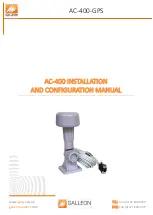
OmniTIK series
This User Manual covers OmniTik models: RBOmniTikG-5HacD (OmniTIK 5 ac), RBOmniTikPG-5HacD (OmniTIK 5 PoE ac), RBOmniTikUPA-5HnD
(OmniTIK 5 PoE), RBOmniTikU-5HnD (OmniTIK 5)
Safety Information:
Before you work on any MikroTik equipment, be aware of the hazards involved with electrical circuitry and be familiar with standard practices for
preventing accidents. The installer should be familiar with RouterOS software and RouterBOARD products, network structures, terms, and
concepts.
Use only the power supply and accessories approved by the manufacturer, and which can be found in the original packaging of this product.
This equipment is to be installed by trained and qualified personnel, as per these installation instructions. The installer is responsible for making
sure, that the Installation of the equipment is compliant with local and national electrical codes. Do not attempt to disassemble, repair, or modify
the device.
This product is intended to be mounted outdoors on a pole. Please read the mounting instructions carefully before beginning installation. Failure
to use the correct hardware and configuration or to follow the correct procedures could result in a hazardous situation to people and damage to
the syste .
m
We cannot guarantee that no accidents or damage will occur due to the improper use of the device. Please use this product with care and operate
at your own risk!
This is a Class A product. In a domestic environment, this product might cause radio interference in which case the user might be required to take
adequate measures.
Technical specifications, brochures and more info about products at
Configuration manual for software with additional information can be found at
https://mikrotik.com/consultants
First use
First Ethernet is always configured as WAN port (protected by a firewall, enabled DHCP client and disabled MAC connection/discovery). Other Ethernet
ports and wireless interfaces are added to the local LAN bridge with 192.168.88.1/24 address set and configured DHCP server.
Open the bottom lid.
Connect your PC or LAN cables to the Ethernet ports.
Connect power source as described in the Powering section.
Set LAN computer IP configuration to automatic (DHCP).
The Default IP address of the unit is 192.168.88.1, open this address in your web browser to start the configuration. The username is admin and
there is no password.
We recommend clicking the "Check for updates" button and updating your RouterOS software to the latest version to ensure the best
performance and stability.
Choose your country, to apply country regulation settings and set up your password on the screen that loads.
We recommend clicking the "Check for updates" button and updating your RouterOS software to the latest version to ensure the best performance and
stability. RouterOS includes many configuration options in addition to what is described in this document. We suggest visiting the RouterOS documentation
page to get yourself accustomed to the possibilities:
In case IP connection is not available, the Winbox tool (
) can be used to connect to the MAC address of the device from the LAN side
(all access is blocked from the internet port by default).
Powering
The device accepts power in the following ways:
Ethernet port accepts passive PoE 10-57 V DC .
This device needs to be upgraded to RouterOS v6.46 or the latest version to ensure compliance with local authority regulations.
It is the end users responsibility to follow local country regulations, including operation within legal frequency channels, output power, cabling
requirements, and Dynamic Frequency Selection (DFS) requirements. All MikroTik radio devices must be professionally installed.
























